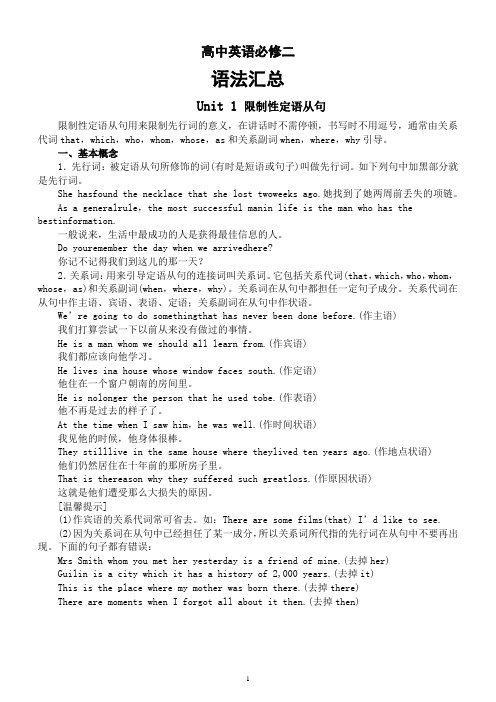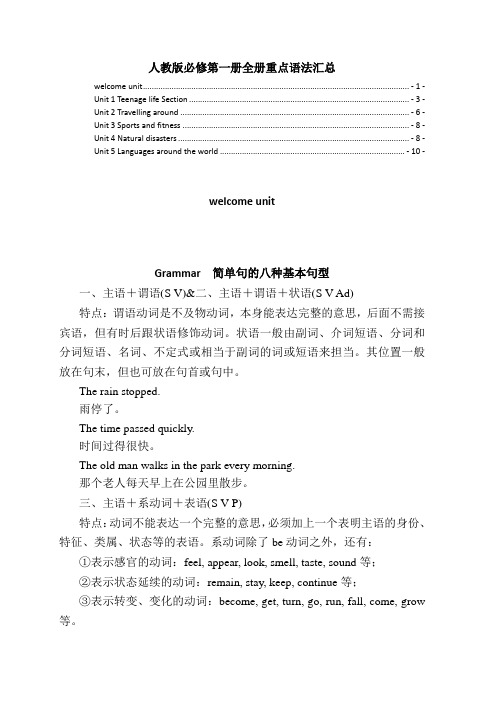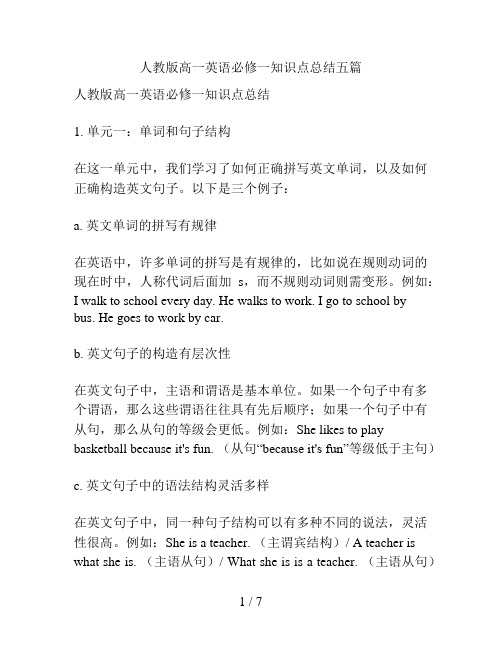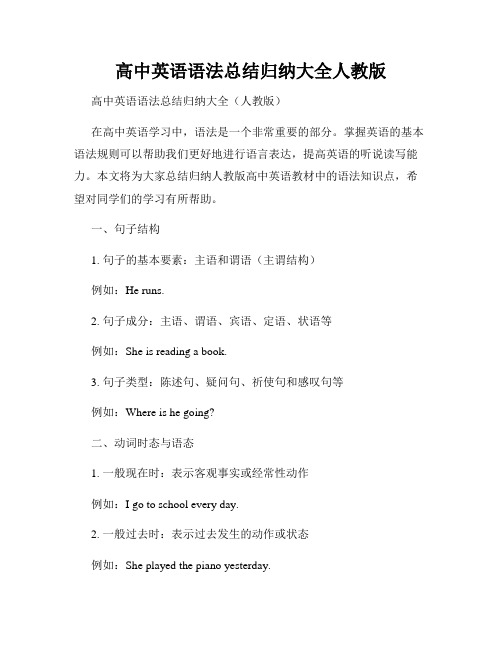人教版高中英语教材语法知识点分布范文
高中英语新人教版必修二全册语法汇总(分单元编排)

高中英语必修二语法汇总Unit 1 限制性定语从句限制性定语从句用来限制先行词的意义,在讲话时不需停顿,书写时不用逗号,通常由关系代词that,which,who,whom,whose,as和关系副词when,where,why引导。
一、基本概念1.先行词:被定语从句所修饰的词(有时是短语或句子)叫做先行词。
如下列句中加黑部分就是先行词。
She hasfound the necklace that she lost twoweeks ago.她找到了她两周前丢失的项链。
As a generalrule,the most successful manin life is the man who has the bestinformation.一般说来,生活中最成功的人是获得最佳信息的人。
Do youremember the day when we arrivedhere?你记不记得我们到这儿的那一天?2.关系词:用来引导定语从句的连接词叫关系词。
它包括关系代词(that,which,who,whom,whose,as)和关系副词(when,where,why)。
关系词在从句中都担任一定句子成分。
关系代词在从句中作主语、宾语、表语、定语;关系副词在从句中作状语。
We’re going to do somethingthat has never been done before.(作主语)我们打算尝试一下以前从来没有做过的事情。
He is a man whom we should all learn from.(作宾语)我们都应该向他学习。
He lives ina house whose window faces south.(作定语)他住在一个窗户朝南的房间里。
He is nolonger the person that he used tobe.(作表语)他不再是过去的样子了。
At the time when I saw him,he was well.(作时间状语)我见他的时候,他身体很棒。
新教材 人教版高中英语必修第一册全册各单元重点语法汇总

人教版必修第一册全册重点语法汇总welcome unit ......................................................................................................................... - 1 -Unit 1 Teenage life Section .................................................................................................... - 3 -Unit 2 Travelling around ........................................................................................................ - 6 -Unit 3 Sports and fitness ....................................................................................................... - 8 -Unit 4 Natural disasters ......................................................................................................... - 8 -Unit 5 Languages around the world .................................................................................... - 10 -welcome unitGrammar简单句的八种基本句型一、主语+谓语(S V)&二、主语+谓语+状语(S V Ad)特点:谓语动词是不及物动词,本身能表达完整的意思,后面不需接宾语,但有时后跟状语修饰动词。
人教版高中英语语法归纳总结

人教版高中英语语法归纳总结一、引言本篇文章旨在为高中生提供一份全面而简洁的人教版高中英语语法归纳总结。
通过此总结,学生们可以更好地理解和掌握高中阶段所学的各种语法知识点,为以后的英语学习打下坚实的基础。
二、语法知识点归纳1. 名词* 名词的数(单数/复数)* 名词的性(阳性/阴性)* 名词的所有格* 名词的用法(可数/不可数)2. 动词* 动词的时态(现在/过去/将来时)* 动词的语态(主动/被动)* 动词的语气(一般/进行/完成)* 动词的常用短语和搭配3. 形容词和副词* 形容词和副词的级(原级/比较级/最高级)* 形容词和副词的用法(修饰名词/修饰动词)* 常用形容词和副词的比较级和最高级规则及不规则变化4. 代词和数词* 人称代词、物主代词、反身代词的用法* 疑问代词和关系代词的用法* 数词的用法(表示数量/时间/顺序)5. 介词和连词* 常用介词的用法(表示地点/方向/方式/比较)* 连词的用法(并列/承接/转折)6. 句子结构* 主语、谓语、宾语、表语、定语、状语的用法* 简单句、并列句、复合句的用法* 句子成分的省略和替代的规则三、重点语法规则总结1. 数的一致性:在句子中,名词的数需要与谓语保持一致,以确保句子的清晰和正确。
需要特别注意可数名词的单复数形式和动词数的变化。
2. 时态和语态的正确使用:在描述过去事件,表达持续状态或说明将来动作时,我们需要选择正确的时态和语态。
同时,注意一些特殊的语法结构,如进行时表达已完成的动作。
3. 形容词和副词的比较级和最高级:掌握比较级的用法和规则,了解如何使用than,as…as结构以及如何表达最高级别的比较。
4. 代词和数词的使用:正确使用代词,避免混淆主语和宾语;正确使用数词,表示数量、时间或顺序。
特别注意反身代词的正确使用。
5. 介词的使用:介词是表达空间、时间、比较等概念的关键词。
需要熟悉常用介词的用法,了解介词与名词、形容词等的搭配。
(完整版)人教版高中英语必修语法知识点总结

高中必修一到必修五主要语法点必修一:直接引语和间接引语(宾语从句);现在进行时表将来;定语从句必修二:定语从句(非限定定从、定从中的介词前提);被动语态(一般将来时、现在完成时及现在进行时的被动语态) 必修三:情态动词;名词性从句(主语从句、宾语从句、表语从句及同位语从句)必修四:主谓一致;非谓语动词(V-ing) ;构词法必修2 第一单元,非限制性定语从句的第二单元一般将来时的主被动第三单元现在完成时的主被动第四单元现在进行时的主被动第五单元介词+which/whom的用法必修3 一二单元情态动词的用法三单元宾语从句和表语从句四单元主语从句五单元同位语从句必修4 第一单元主谓一致第二单v-ing作主语和宾语的用法第三单元v-ing作表语,定语和宾语补足语第四单元v-ing作状语第五单元构词法必修5 第一单元过去分词作定语和表语第二单元过去分词作宾语补足语第三单元过去分词作状语第四单元倒装句第五单元省略句必修一各单元知识点总结Unit One Friendship一、重点短语1.go through 经历,经受get through 通过;完成;接通电话2. set down 记下,放下3. a series of 一系列4 on purpose 有目的的5. in order to 为了6. at dusk 傍晚,黄昏时刻7. face to face 面对面8. fall in love 爱上9. join in 参加(某个活动);take part in 参加(活动)join 加入(组织,团队,并成为其中一员)10. calm down 冷静下来11. suffer from 遭受12. be/get tired of…对…感到厌倦13. be concerned about 关心14. get on/along well with 与…相处融洽15. be good at/do well in 擅长于…16. find it + adj. to do sth. 发现做某事是…17. no longer / not …any longer 不再…18. too much 太多(后接不可数n.)much too 太…(后接adj.)19. not…until 直到…才20. it’s no pleasure doing sth 做…并不开心21. make sb. sth. 使某人成为…make sb. do sth. 使某人做某事二、语法----直接引语和间接引语概念:直接引语:直接引述别人的原话。
高中英语人教版《英语语法》知识点归纳总结.doc

高中英语人教版《英语语法》知识点归纳总结一冠词冠词分为不定冠词(a a n,),定冠词(the),和零冠词。
I.不定冠词的用法1指一类人或事,相当于a kind of A plane is a machine that can fly.2第一次提及某人某物,非特指A boy is waiting for you.有个男孩在等你。
3表示“每一”相当于every,one We study eight hours a day.4表示“相同”相当于the same We are nearly of an age.—Hello,could I speak to Mr.Smith?—Sorry,wrong number.There isn't______Mr.S 用于人名前,表示不认识此人或与某名mith here.5人有类似性质的人或事A.不填B.aC.theD.oneThat boy is rather a Lei Feng.(活雷锋)a couple of,a bit,once upon a time,in a hurr 6用于固定词组中y,have a walk,many a time用于quite,rather,many,half,7This room is rather a big one.what,such之后8用于so(as,too,how)+形容词之后She is as clever a girl as you can wish to mee1t.success(抽象名词)→s a uccess(具体化) 成功的人或事a failure失败的人或事a shame带来耻辱的人或事9用于抽象名词具体化的名词前a pity可惜或遗憾的事a must必需必备的事a good knowledge of精通掌握某一方面的知识II.定冠词的用法In many places in China,___bicycle is still___popular means of transportation. 1表示某一类人或物A.a;theB./;aC.the;aD.the;the用于世上独一无二的事2the universe,the moon,the Pacific Ocean物名词前表示说话双方都了解的3Would you mind opening the door?或上文提到过的人或事4用于演奏乐器play the violin,play the guitar用于形容词和分词前表5the reach,the living,the wounded示一类人表示“一家人”或“夫妇”—Could you tell me the way to____Johnsons,please?6—Sorry,we don’t have____Johnson here in the village.(对比上文的不定冠词用法5) A.the;theB.the;aC./;theD.the;/2。
人教版高一英语必修一知识点总结五篇

人教版高一英语必修一知识点总结五篇人教版高一英语必修一知识点总结1. 单元一:单词和句子结构在这一单元中,我们学习了如何正确拼写英文单词,以及如何正确构造英文句子。
以下是三个例子:a. 英文单词的拼写有规律在英语中,许多单词的拼写是有规律的,比如说在规则动词的现在时中,人称代词后面加s,而不规则动词则需变形。
例如:I walk to school every day. He walks to work. I go to school by bus. He goes to work by car.b. 英文句子的构造有层次性在英文句子中,主语和谓语是基本单位。
如果一个句子中有多个谓语,那么这些谓语往往具有先后顺序;如果一个句子中有从句,那么从句的等级会更低。
例如:She likes to play basketball because it's fun. (从句“because it's fun”等级低于主句)c. 英文句子中的语法结构灵活多样在英文句子中,同一种句子结构可以有多种不同的说法,灵活性很高。
例如:She is a teacher. (主谓宾结构)/ A teacher is what she is. (主语从句)/ What she is is a teacher. (主语从句)2. 单元二:课文阅读在这一单元中,我们学习了如何正确理解英文课文的内容,并提高了对英文阅读的兴趣和能力。
以下是三个例子:a. 英文课文中的语言运用丰富多样英文课文中的语言运用很丰富,包括比喻、暗示、转喻等等,需要我们认真阅读并理解。
例如:The sky was a bright shade of blue. (比喻)/ Her words cut him like a knife. (转喻)b. 英文课文中的句式多种多样英文课文中的句式也很多样,有短句和长句、简单句和复合句等等。
我们需要慢慢地理解它们,并掌握如何从中获取信息。
新教材 人教版高中英语选择性必修第一册各单元重点语法汇总

人教版选择性必修第一册各单元重点语法汇总Unit 1 People of Achievement.................................................................................................. - 1 - Unit 2 Looking into the Future ................................................................................................. - 5 - Unit 3 Fascinating Parks ........................................................................................................... - 9 - Unit 4 Body Language ............................................................................................................ - 12 - Unit 5 Working the Land ........................................................................................................ - 19 -Unit 1 Peopl e of Achievement定语从句一、定语从句的种类根据定语从句与先行词之间关系的紧密程度,我们将定语从句分为限制性定语从句和非限制性定语从句两种。
【观察例句】This is the computer (that/which) he bought for his son yesterday.这是他昨天为儿子买的电脑。
高中英语语法总结归纳大全人教版

高中英语语法总结归纳大全人教版高中英语语法总结归纳大全(人教版)在高中英语学习中,语法是一个非常重要的部分。
掌握英语的基本语法规则可以帮助我们更好地进行语言表达,提高英语的听说读写能力。
本文将为大家总结归纳人教版高中英语教材中的语法知识点,希望对同学们的学习有所帮助。
一、句子结构1. 句子的基本要素:主语和谓语(主谓结构)例如:He runs.2. 句子成分:主语、谓语、宾语、定语、状语等例如:She is reading a book.3. 句子类型:陈述句、疑问句、祈使句和感叹句等例如:Where is he going?二、动词时态与语态1. 一般现在时:表示客观事实或经常性动作例如:I go to school every day.2. 一般过去时:表示过去发生的动作或状态例如:She played the piano yesterday.3. 一般将来时:表示将来要发生的动作或状态例如:They will visit their grandparents next week.4. 现在进行时:表示现在正在进行的动作例如:We are watching a movie now.5. 过去进行时:表示过去某一时刻正在进行的动作例如:He was studying when I called him.6. 现在完成时:表示过去发生的动作与现在的关系例如:I have finished my homework.7. 被动语态:表示动作的接受者例如:The book was written by him.三、名词与冠词1. 可数名词与不可数名词例如:a book(可数名词)、water(不可数名词)2. 冠词的用法:定冠词(the)、不定冠词(a/an)和零冠词(不使用冠词)例如:I have a cat.四、形容词与副词1. 形容词的用法:修饰名词或代词例如:a beautiful girl2. 副词的用法:修饰动词、形容词、副词等例如:She runs fast.五、介词与介词短语1. 介词的用法:表示时间、地点、方向、原因等例如:at school、in the park、to the cinema2. 介词短语的用法:由介词和它的宾语构成的短语例如:in front of、on the table、with a smile六、连接词与从句1. 连接词的分类:并列连词(and、but)、从属连词(because、if)等例如:I like swimming and dancing.2. 名词性从句:作主语、宾语、表语等的从句例如:What he said is true.3. 定语从句:修饰名词或代词的从句例如:The book that I borrowed is interesting.七、虚拟语气与情态动词1. 虚拟语气的用法:表示假设、愿望、建议等例如:If I were rich, I would buy a big house.2. 情态动词的用法:表示能力、可能、许可等例如:You should study hard.八、直接引语与间接引语1. 直接引语:直接引述他人的话例如:He said, "I am busy."2. 间接引语:将他人的话转述出来例如:He said that he was busy.九、固定搭配与习惯用语1. 固定搭配:一些常用的短语或固定的词组例如:take care of、make progress2. 习惯用语:在日常用语中经常出现的表达方式例如:How are you?、Thank you.综上所述,以上是人教版高中英语教材中的一些重要语法知识点的总结归纳。
- 1、下载文档前请自行甄别文档内容的完整性,平台不提供额外的编辑、内容补充、找答案等附加服务。
- 2、"仅部分预览"的文档,不可在线预览部分如存在完整性等问题,可反馈申请退款(可完整预览的文档不适用该条件!)。
- 3、如文档侵犯您的权益,请联系客服反馈,我们会尽快为您处理(人工客服工作时间:9:00-18:30)。
情态动词2:
ought to/ought not to/have to/don’t have to/mustn’t/needn’t
第三单元
名词性从句1:作为宾语和表语
第四单元
名词性从句2:作为主语
第五单元
名词性从句3:作为同位语
必修四
单元
语法点
第一单元
主谓一致
第二单元
非谓语动词:ing形式作主语和宾语
必修二
单元
语法点
第一单元
定语从句3:限制性定语从句和非限制性定语从句
第二单元
语态:一般将来时的被动语态
第三单元
语态:现在完成时的被动语态
第四单元
语态:现在进行时的被动语态
第五单元
定语从句4:介词+which/whom
高一年级下学期
必修三
单元
语法点
第一单元
情态动词1:
may/might/, can/could, will/would, shall/should, must/can’t
选修六
单元
语法点
第一单元
虚拟语气1:
I wish, I could/did/would…
If I did…, I would do…
第二单元
虚拟语气2:
If I had done…, I would have done…
第三单元
It的特殊用法(1)
第四单元
It的特殊用法(2)
第五单元
复习ing形式
高二年级下学期
选修七
单元
语法点
第一单元
复习不定式
第二单元
复习被动语态1:包括不定式
第三单元
复习被动语态2:包括ing形式
第习非限制性定语从句
选修八
单元
语法点
第一单元
复习名词性从句:作为主语、宾语和表语
第二单元
复习单词、短语和从句作同位语
第三单元
复习非谓语动词:过去分词形式作定语、表语和宾语补足语
第四单元
复习非谓语动词:过去分词形式作状语
第五单元
复习动词时态:包括现在完成进行时
第三单元
非谓语动词:ing形式作表语、定语和宾语补足语
第四单元
非谓语动词:ing形式作定语和状语
第五单元
合成词
高二年级上学期
必修五
单元
语法点
第一单元
非谓语动词:过去分词形式作定语、表语
第二单元
非谓语动词:过去分词形式作宾语补足语
第三单元
非谓语动词:过去分词形式作状语、定语
第四单元
倒装句
第五单元
省略句
人教版高中英语语法知识点分布一览表
高一年级上学期
必修一
单元
语法点
第一单元
直接引语间接引语1:陈述句和疑问句
第二单元
直接引语间接引语2:请求和命令
第三单元
时态:现在进行时表将来
第四单元
定语从句1:that, which, whom, whose
第五单元
定语从句2:when, where, why,介词+which/whom
